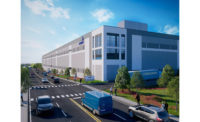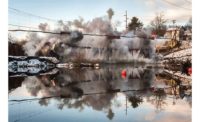NY and NJ Builders Report Moderate Revenue Rise

Triton Construction counts Queens Plaza Towers among current projects, though COO Lance Franklin says the ultraluxury condo market is cooling.
PHOTO COURTESY TRITON CONSTRUCTION CO.

Holt Construction performed the first airlift at JFK Airport to install an HVAC system at ARK, a facility where traveling animals are cared for or quarnatined.
PHOTO BY MICHAEL VASILEV/HOLT CONSTRUCTION

Transportation revenue for the region grew almost 21% from last year, in part due to the massive overhaul at LaGuardia Airport.
PHOTO COURTESY SKANSKA

AECOM-Tishman is using its OneDesign process in the construction of One Vanderbilt, allowing steel erection and MEP erection to start ahead of schedule.
PHOTO COURTESY AECOM-TISHMAN




Slow and steady is how the construction industry performed last year. The 60 top companies ranked on ENR New York’s 2018 Top Contractors list—all reporting more than $20 million in 2017 revenue from work in New York and New Jersey—generated a regional total of $26.17 billion. That’s 5.4% higher than last year’s ranking, when the 60 largest firms reported 2016 revenue of $24.83 billion.
A close look at the numbers shows mixed results for firms, with differences based on size and market sector. The top five firms in this year’s ranking managed to grow revenue by 8%, reporting $12.14 billion in revenue compared with $11.24 billion for that group last year. Regional revenue for the 50 largest contractors rose 7.3% to $25.75 billion from $24 billion last year, a clear slowdown from the 14.3% increase seen when comparing last year’s figure with the prior year’s total.
Sector vagaries counterbalanced each other, although growth tipped the seesaw overall. The top 10 firms reported a slight hike in revenue from New Jersey-based work, to $3.33 billion from $3.03 billion. But the government sector slowed to $157.35 million for firms in 2017, a 34.62% decline from $240.45 million they reported in 2016. Multi-unit residential work stayed fairly steady at $4.78 billion.
Work in New York state generated double-digit growth for firms, up 19% to $16.56 billion from $13.89 billion on last year’s ranking. Transportation rose to $3.01 billion, up 20.88% from $2.49 billion; while those reporting commercial revenue saw it grow a whopping 60% to $3.28 billion from $2.05 billion,
Executives of some of the firms on this year’s Top Contractors list shared with ENR New York their insights on what made sectors hot—or not. Even with the differences, the big consensus was that lack of talent is the top challenge for the AEC industry moving forward into next year. Responses t have been edited for space and clarity.
ENR New York 2018 Top Contractors
What major trends have you seen among clients or in RFPs during the past year?
Anthony Rinaldi, president and CEO, The Rinaldi Group: We see developers shifting gears toward office building developments as well as seeking alternative residential marketplaces outside of New York City such as Westchester County, Jersey City and Newark. While we continue to hear how the NYC hospitality and hotel marketplace is saturated, many of our developers are still building hotels throughout the city. With NYC breaking tourism records in each of the past eight years … we haven’t yet seen a hotel development slowdown.
Lance Franklin, COO, Triton Construction Co: We are working on and have seen several new boutique office buildings being planned and built around the city. We have completed three, have a fourth in construction and are in preconstruction on an additional two.
Christopher Asaro, president, Holt Construction: Increased competition due to open shop [growth] is a trend we are seeing. Within RFPs, we also have seen increased requirements in terms of safety and expeience, as well as level of technical knowledge pertaining to staff. This has made us rethink the traditional response to an RFP.… Not only does the company collaborate [more] in response, we [also use] nontraditional tools and collaborative software to streamline the process through an elite team [chosen to respond].
Jay Badame, president and COO, AECOM-Tishman: Today, owners are more involved not only in the design but also in the construction process.
What sector has offered your firm the best opportunity?
Rinaldi: The hospitality and hotel sector has provided the greatest opportunity… while we are also experiencing a rise in office building construction projects.
Asaro: We see the health care space [offering opportunities] with drivers including industry consolidation, acquisition of physician practices, construction of urgent care centers, new ambulatory care facilities, single patient rooms [and] expanded emergency rooms. Additional drivers include the Affordable Care Act and 30 million newly insured patients, and the ‘silver tsunami’ [of more people age 65 and older]. There’s also the aviation sector, due to upgrading of major airports and infrastructure. We are seeing a shift in the airport experience from just passenger hold rooms to first class eating experiences and high-end shopping.
Badame: Our strong growth the last couple of years is largely driven by an unprecedented boom in projects greater than $1 billion. … Density is the future, both in commercial and residential construction.
What sector is cooling down?
Franklin: We have seen a slowdown in ultra-luxury condominium projects moving forward with the cost of construction, land and carrying.
Rinaldi: We have watched the cost of purchasing property in Manhattan and much of the outer boroughs reach such highs that the price makes residential development and, in particular, rental development impossible. It is eerily trending like it did in 2007, when the cost of “dirt” [properties] reached such heights that it prohibited further residential development from being viable.
Asaro: In our own studies we have seen higher education and private institutions in addition to retail sectors cooling down due to a decrease of traditional brick and mortar locations [and] to the rise of online retail and educational services. This has given us the opportunity to pursue alternate forms of these markets, including small high-end boutique [shops] and [specialized spaces] in higher education [like] gymnasiums.
What have been major challenges for your firm?
Franklin: The subcontractors are all spread thin. Choosing the right subcontractor team is critical to the success of any project.
Rinaldi: The biggest challenge for us today is the availability of talent. Whether it be construction professionals with degrees and licenses to manage our construction projects and build our developments or trained and skilled craftsmen and construction labor, the pool from which to draw and find the needed numbers is severely limited. [Thus] the cost is equally becoming prohibitive with the salary and labor-rate demands coming from the candidates far exceeding and outweighing the budgets previously carried by developers. As a construction manager and general contractor, we are being squeezed [from] both sides.
Asaro: As construction continues to be in high demand due to prime real estate locations seeing a boom, challenges include acquiring qualified talent. Holt is continually developing new programs within the company to obtain talented project managers. We continually evolve and research not just what project managers are looking for, but to develop processes to find the best talent within these markets.
Where do you see the industry headed in the next year?
Dale Errico, vice president of business development, Railroad Construction Co: Toward more public-private-partnership and design-build projects.
Franklin: Triton is in a unique place given our experience ... and ability to hire both union and nonunion subcontractors. We have been able to use this to be extremely competitive and more flexible than the larger construction managers in the city.
Rinaldi: We are seeing trends toward office building construction and development in Manhattan and outer boroughs, while residential [is] moving out of the city and into [locations with] access to mass transit into and close proximity to New York City.
Asaro: With the high demand of new real estate, owners are expecting projects to be completed faster than ever. [There will be] increased use of project management firms as owners do not have the staff numbers or experience to manage the volume of projects being constructed.
Badame: Thanks to new zoning laws around midtown east, NYC will grow even taller. New York City has already seen a 500% increase in the number of supertall towers in the last four years. … Adaptive building laws are opening the doors to construct taller.
What key innovations used on your projects last year boosted productivity or other metrics?
Asaro: [Holt’s airlift operation to install HVAC equipment for ARK, a facility to house traveling animals at JFK Airport] was the first airlift of any kind to take place at JFK. The Port Authority of New York and New Jersey and other agencies were unaware of the procedures and protocols surrounding such operations. Holt set the standard by presenting a highly coordinated safety plan. Completing an airlift in lieu of using a conventional crane improved the schedule and also was able to reduce budget costs. The one-day setup and one-day breakdown of the crane was eliminated. The trucking and permitting costs to bring the crane to the site were also eliminated.
Badame: Our emerging technologies practices continue to drive efficiency in our projects. Through a proprietary process called OneDesign, we are coordinating major MEP systems sooner to allow for greater flexibility and price certainty at the time of an MEP [contract] award. We utilized OneDesign at One Vanderbilt, allowing steel erection and MEP coordination to begin ahead of schedule. We continue to push BIM with 4D sequences, enabling us to visualize logistics well in advance. We just used this technology on 30 Hudson Yards’ observation deck.








